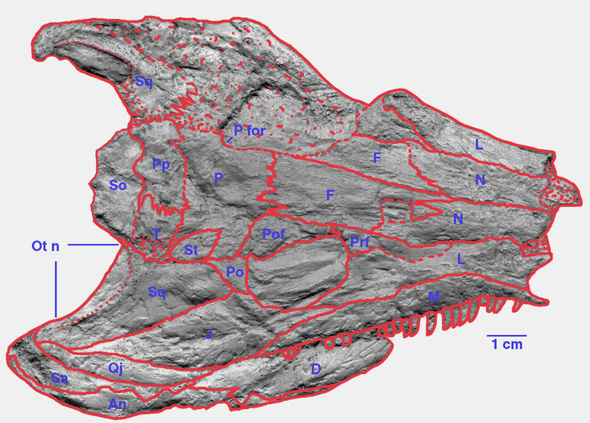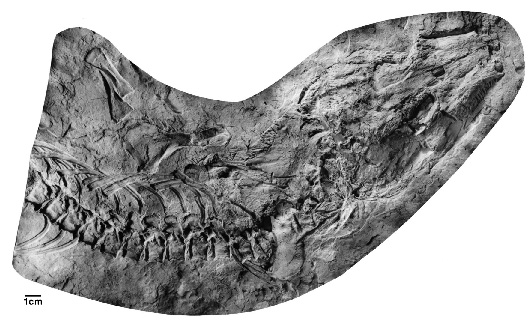Solenodonsaurus
Solenodonsaurus janenschi
Michel Laurin
Introduction
Solenodonsaurus janenschi (the only recognized species of Solenodonsaurus) is a small extinct tetrapod that measured about 45 cm (snout-vent length). It was probably carnivorous or insectivorous, as shown by its sharp, slightly curved teeth. It has played a prominent role in discussions on the origin of amniotes (see the Relationships of Solenodonsaurus to Other Stegocephalians section), even though it lived too late (in the Westphalian D, Upper Carboniferous) to ever be considered an ancestor of amniotes (that appear slightly earlier, in the Westphalian B).
Characteristics
The skull of Solenodonsaurus possesses a shallow temporal emargination (also called an otic notch). This emargination (Fig. 1) is shallower than in most other early stegocephalians, and its shape is unsuitable to have supported a tympanum. Thus, Solenodonsaurus could probably not hear high-frequency air-borne sounds very well, if at all.


Figure 1. Skull of Solenodonsaurus in dorsal view. Abbreviations: An, angular; D, dentary; F, frontal; J, jugal; L, lacrimal; M, maxilla; N, nasal; Ot n, otic notch; P, parietal; P for, pineal foramen; Po, postorbital; Pof, postfrontal; Pp, postparietal; Prf, prefrontal; Qj, quadratojugal; Sa, surangular; So, supraoccipital; Sq, squamosal; St, supratemporal; T, tabular. Pictures copyright © 2001 Michel Laurin.
Its humerus was fairly robust, with strongly expanded proximal and distal heads (Fig. 2). There appears to have been a single sacral rib. Its neural arches were not swollen, unlike those of seymouriamorphs and diadectomorphs. As in many other early stegocephalians, its skin was reinforced by long ventral (Fig. 2, Ga) and circular dorsal, bony scales.
Unfortunately, our knowledge of the skeletal anatomy of this taxon is poor because only a few incomplete skeletons are known. The preserved skulls are also poor. Therefore, the path of some of the sutures on the skull is uncertain (Fig. 1; as shown by dashed lines).


Figure 2. Skeleton of Solenodonsaurus in dorsal view. Abbreviations: Cl, clavicla; Cr, cervical rib; Ct, cleithrum; En for, entepicondylar foramen; Ga, gastralia; H, humerus; Ic, intercentrum; Icl, interclavicle; Ra, radius; Sco, scapulocoracoid; Sk, skull; U, ulna. Pictures copyright © 2001 Michel Laurin.
Relationships of Solenodonsaurus to Other Stegocephalians
Solenodonsaurus was erected and described by Broili (1924), who considered that it was a "cotylosaur" (a group that included some early amniotes and their presumed closest known relatives). Its teeth lack the labyrinthine infolding primitively found in stegocephalians, and this is one of the characters (the other being the morphology of the vertebral centrum) that led Broili (1924) to suggest that this animal was an amniote (a "reptile", in his terminology). Its interclavicle has a long posterior stem (Fig. 2), and this has long been thought to unite it with other anthracosaurs, but this character has a broader distribution (Laurin & Reisz, 1997). The vertebral centrum of Solenodonsaurus (Fig. 2) resembles that of seymouriamorphs, diadectomorphs, early amniotes and some early amphibians. It consists of a large, cylindrical pleurocentrum and a small, crescentic intercentrum. Other characters that were taken as evidence of amniote affinities of Solenodonsaurus are the absence of an intertemporal and the presence of a supraoccipital and of a contact between the tabular and the parietal. However, most of these characters have a broader distribution (Laurin & Reisz, 1997).
Subsequent studies confirmed that Solenodonsaurus was either an early amniote or a close relative of amniotes (Pearson, 1924; Brough & Brough, 1967; Carroll, 1970). The advent of cladistics clarified somewhat the position Solenodonsaurus; this taxon was considered to be definitely outside Amniota, but to be closely related to the clade that includes diadectomorphs and amniotes (Gauthier, Kluge & Rowe, 1988).
In a recent analysis that included amphibians (Laurin & Reisz, 1999), Solenodonsaurus appears to be the sister-group of all other known anthracosaurs (amniotes and their extinct relatives).
References
Broili F. v. 1924. Ein Cotylosaurier aus der oberkarbonischen Gaskohle von Nürschan in Böhmen. Sitzungsberichte der Mathematisch-Naturwissenschaftlichen Abteilung der Bayerischen Akademie der Wissenschaften zu München 1924: 3-11.
Brough M. C. & J. Brough. 1967. Studies on early tetrapods. III. The genus Gephyrostegus. Philosophical Transactions of the Royal Society B252: 147-165.
Carroll R. L. 1970. The ancestry of reptiles. Philosophical Transactions of the Royal Society B257: 267-308.
Gauthier J., A. G. Kluge, & T. Rowe. 1988. The early evolution of the Amniota. In: M. J. Benton (ed.) The phylogeny and classification of the tetrapods, Volume 1: amphibians, reptiles, birds (1): 103-155. Oxford: Clarendon Press.
Laurin M. & R. R. Reisz. 1997. A new perspective on tetrapod phylogeny. In: S. Sumida and K. Martin (eds) Amniote Origins—Completing the Transition to Land: 9-59. London: Academic Press.
Laurin M. & R. R. Reisz. 1999. A new study of Solenodonsaurus janenschi, and a reconsideration of amniote origins and stegocephalian evolution. Canadian Journal of Earth Sciences 36: 1239-1255.
Pearson H. S. 1924. Solenodonsaurus, Broili, a seymouriamorph reptile. Annals and Magazine of Natural History 14: 338-343.
Title Illustrations

| Scientific Name | Solenodonsaurus janenschi |
|---|---|
| Reference | Reproduced from Laurin M. & R. R. Reisz. 1999. A new study of Solenodonsaurus janenschi, and a reconsideration of amniote origins and stegocephalian evolution. Canadian Journal of Earth Sciences 36:1239-1255. |
| Specimen Condition | Fossil |
| Body Part | skeleton |
| Copyright | © 1999 Michel Laurin and Robert Reisz |
About This Page
I thank Dr. Katja Schulz for technical assistance.
Michel Laurin

Muséum National d'Histoire Naturelle, Paris, France
Correspondence regarding this page should be directed to Michel Laurin at
Page copyright © 2011 Michel Laurin
 Page: Tree of Life
Solenodonsaurus. Solenodonsaurus janenschi.
Authored by
Michel Laurin.
The TEXT of this page is licensed under the
Creative Commons Attribution License - Version 3.0. Note that images and other media
featured on this page are each governed by their own license, and they may or may not be available
for reuse. Click on an image or a media link to access the media data window, which provides the
relevant licensing information. For the general terms and conditions of ToL material reuse and
redistribution, please see the Tree of Life Copyright
Policies.
Page: Tree of Life
Solenodonsaurus. Solenodonsaurus janenschi.
Authored by
Michel Laurin.
The TEXT of this page is licensed under the
Creative Commons Attribution License - Version 3.0. Note that images and other media
featured on this page are each governed by their own license, and they may or may not be available
for reuse. Click on an image or a media link to access the media data window, which provides the
relevant licensing information. For the general terms and conditions of ToL material reuse and
redistribution, please see the Tree of Life Copyright
Policies.
- First online 02 May 2001
Citing this page:
Laurin, Michel. 2001. Solenodonsaurus. Solenodonsaurus janenschi. Version 02 May 2001. http://tolweb.org/Solenodonsaurus_janenschi/14992/2001.05.02 in The Tree of Life Web Project, http://tolweb.org/









 Go to quick links
Go to quick search
Go to navigation for this section of the ToL site
Go to detailed links for the ToL site
Go to quick links
Go to quick search
Go to navigation for this section of the ToL site
Go to detailed links for the ToL site